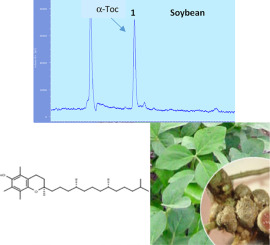当前位置:
X-MOL 学术
›
Phytochemistry
›
论文详情
Our official English website, www.x-mol.net, welcomes your feedback! (Note: you will need to create a separate account there.)
Vitamin E in legume nodules: Occurrence and antioxidant function
Phytochemistry ( IF 3.8 ) Pub Date : 2020-04-01 , DOI: 10.1016/j.phytochem.2020.112261 David Soba 1 , Maren Müller 2 , Iker Aranjuelo 1 , Sergi Munné-Bosch 2
Phytochemistry ( IF 3.8 ) Pub Date : 2020-04-01 , DOI: 10.1016/j.phytochem.2020.112261 David Soba 1 , Maren Müller 2 , Iker Aranjuelo 1 , Sergi Munné-Bosch 2
Affiliation

|
Although the biosynthesis and function of tocochromanols in leaves and seeds have been extensively studied, their occurrence and function in underground tissues, such as roots and nodules, is very poorly understood. Here, we performed a comparative study of the presence of tocochromanols in different plant organs (leaves, roots and nodules) of three legumes (soybean, alfalfa and pea plants). Additionally, we measured variations in tocochromanols as a function of the severity of water stress and evaluated their relationship with the extent of membrane lipid peroxidation and nodule performance (as indicated by thiobarbituric acid-reactive substances assay and 15N isotope labeling, respectively). Results showed the presence of endogenous tocopherols, mainly α-tocopherol, in the three studied organs of the three legumes. Nodules showed higher concentrations of α-tocopherol than roots, but lower than leaves. α-Tocopherol content increased under water shortage in nodules, roots and leaves of soybean as well as in roots of alfalfa, but not in the other plant systems. A strong negative correlation between α-tocopherol and thiobarbituric acid-reactive substances contents was found for roots and especially for nodules. Furthermore, nodule α-tocopherol content positively correlated with nodule N2 fixation (estimated by 15N isotope labeling). We conclude that α-tocopherol is a major antioxidant found in legume nodules.
中文翻译:

豆类结节中的维生素 E:发生和抗氧化功能
尽管已经对叶子和种子中生育色胺醇的生物合成和功能进行了广泛的研究,但对它们在根和根瘤等地下组织中的发生和功能知之甚少。在这里,我们对三种豆科植物(大豆、苜蓿和豌豆植物)的不同植物器官(叶、根和根瘤)中生育色胺醇的存在进行了比较研究。此外,我们测量了生育苯并色醇的变化作为水分胁迫严重程度的函数,并评估了它们与膜脂过氧化程度和结节性能的关系(分别通过硫代巴比妥酸反应性物质测定和 15N 同位素标记表明)。结果表明,在三种豆科植物的三个研究器官中存在内源性生育酚,主要是 α-生育酚。根瘤的α-生育酚浓度高于根,但低于叶。在缺水条件下,大豆的根瘤、根和叶以及苜蓿根部的α-生育酚含量增加,但在其他植物系统中没有。α-生育酚和硫代巴比妥酸反应性物质的含量在根部特别是根瘤中呈强烈负相关。此外,结节 α-生育酚含量与结节 N2 固定呈正相关(通过 15N 同位素标记估计)。我们得出结论,α-生育酚是在豆科植物根瘤中发现的主要抗氧化剂。α-生育酚和硫代巴比妥酸反应性物质含量在根部,尤其是根瘤中呈强烈负相关。此外,结节 α-生育酚含量与结节 N2 固定呈正相关(通过 15N 同位素标记估计)。我们得出结论,α-生育酚是在豆科植物根瘤中发现的主要抗氧化剂。α-生育酚和硫代巴比妥酸反应性物质含量在根部,尤其是根瘤中呈强烈负相关。此外,结节 α-生育酚含量与结节 N2 固定呈正相关(通过 15N 同位素标记估计)。我们得出结论,α-生育酚是在豆科植物根瘤中发现的主要抗氧化剂。
更新日期:2020-04-01
中文翻译:

豆类结节中的维生素 E:发生和抗氧化功能
尽管已经对叶子和种子中生育色胺醇的生物合成和功能进行了广泛的研究,但对它们在根和根瘤等地下组织中的发生和功能知之甚少。在这里,我们对三种豆科植物(大豆、苜蓿和豌豆植物)的不同植物器官(叶、根和根瘤)中生育色胺醇的存在进行了比较研究。此外,我们测量了生育苯并色醇的变化作为水分胁迫严重程度的函数,并评估了它们与膜脂过氧化程度和结节性能的关系(分别通过硫代巴比妥酸反应性物质测定和 15N 同位素标记表明)。结果表明,在三种豆科植物的三个研究器官中存在内源性生育酚,主要是 α-生育酚。根瘤的α-生育酚浓度高于根,但低于叶。在缺水条件下,大豆的根瘤、根和叶以及苜蓿根部的α-生育酚含量增加,但在其他植物系统中没有。α-生育酚和硫代巴比妥酸反应性物质的含量在根部特别是根瘤中呈强烈负相关。此外,结节 α-生育酚含量与结节 N2 固定呈正相关(通过 15N 同位素标记估计)。我们得出结论,α-生育酚是在豆科植物根瘤中发现的主要抗氧化剂。α-生育酚和硫代巴比妥酸反应性物质含量在根部,尤其是根瘤中呈强烈负相关。此外,结节 α-生育酚含量与结节 N2 固定呈正相关(通过 15N 同位素标记估计)。我们得出结论,α-生育酚是在豆科植物根瘤中发现的主要抗氧化剂。α-生育酚和硫代巴比妥酸反应性物质含量在根部,尤其是根瘤中呈强烈负相关。此外,结节 α-生育酚含量与结节 N2 固定呈正相关(通过 15N 同位素标记估计)。我们得出结论,α-生育酚是在豆科植物根瘤中发现的主要抗氧化剂。



























 京公网安备 11010802027423号
京公网安备 11010802027423号